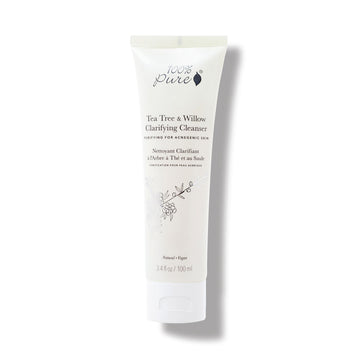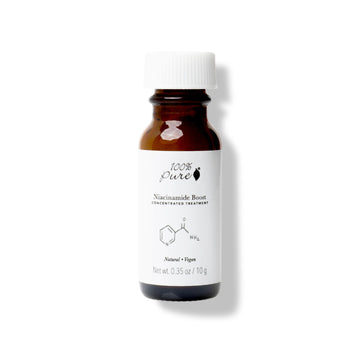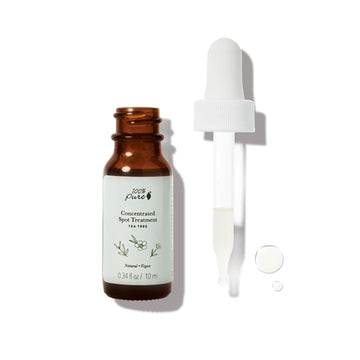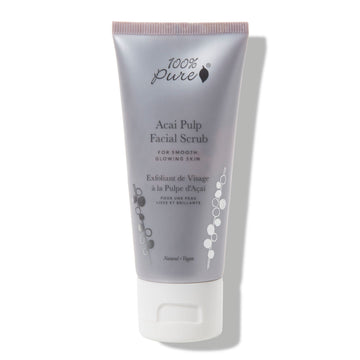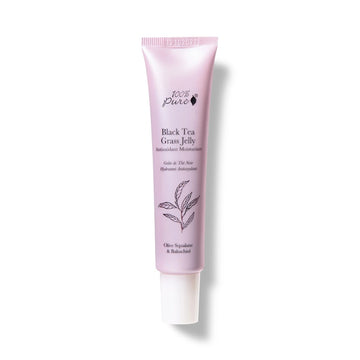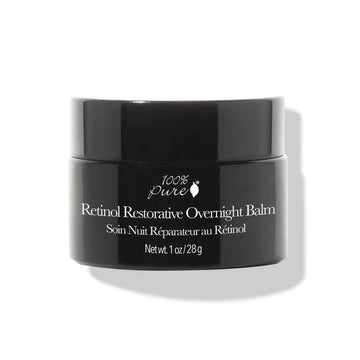Identify Your Acne Type and Find the Best Treatment for Clear, Healthy Skin
Posted on June 18, 2024 Written by: 100% PURE®
The Acne Struggle
Imagine waking up on a bright Monday morning, ready to tackle the week, only to be greeted by a new breakout that seems to have popped up overnight. Your heart sinks as you look in the mirror, horrified by the angry red bumps that weren't there yesterday.
You’ve been diligent with your skincare routine, yet the acne stubbornly persists, mocking your efforts. You’ve tried every over-the-counter product, but nothing seems to work. Could it be that you're using the wrong treatments?
The key to conquering acne lies in identifying whether it’s hormonal or bacterial. Understanding this difference is crucial to finding the most effective treatments and finally achieving clear, glowing skin. Let's dive into how you can tell the difference and what to do about it.
Understanding Acne Types
Many people mistakenly treat acne as a singular issue, reaching for any over-the-counter product in hopes of a quick fix. However, the real challenge often lies in not understanding the specific type of acne they are dealing with, which can lead to ineffective treatments and prolonged frustration. Acne can be broadly categorized into two types: hormonal and bacterial, each with distinct causes and characteristics.
Hormonal Acne
Hormonal acne is driven by fluctuations in hormones, commonly seen during puberty, menstrual cycles, pregnancy, and menopause. This type manifests as deep, cystic pimples typically around the jawline, chin, and cheeks. It is often triggered by hormonal imbalances. Several factors can trigger hormonal acne, including hormonal imbalances, stress, and diet. Foods high in sugar and dairy can exacerbate the condition, while stress can increase cortisol levels, further aggravating the skin.
Bacterial Acne
Bacterial acne, in contrast, is caused by the bacteria Propionibacterium acnes clogging pores and leading to inflammation. This results in whiteheads, blackheads, and pustules that appear on the face, chest, and back. Key triggers for bacterial acne include poor hygiene, excessive oil production, and the use of comedogenic products that block pores. Properly identifying the type of acne is crucial to selecting the most effective treatment and achieving clearer skin.

How to Determine Your Acne Type
Before diving into any acne treatment, it’s crucial to first determine whether your acne is hormonal or bacterial. Misidentifying the type can lead to ineffective treatments, which not only wastes time and money but can also aggravate the condition. By correctly identifying the nature of your acne, you can choose the most appropriate and effective treatment plan. To find your answer, follow these three steps:
Step 1: Observing the Location
Hormonal Acne: Take a close look at where your breakouts are most concentrated. Hormonal acne is typically found along the jawline, chin, and lower face. These areas are particularly sensitive to hormonal fluctuations.
Bacterial Acne: Bacterial acne can appear anywhere on the body but is especially common on the forehead, nose, cheeks, chest, and back. These areas are more prone to bacterial growth and inflammation due to oil and sweat production.
Step 2: Evaluating the Symptoms
Hormonal Acne: Examine the nature of your pimples. Hormonal acne often consists of deep, painful cysts that don’t come to a head. These cysts can be tender to touch and feel like lumps under the skin.
Bacterial Acne: Bacterial acne tends to produce surface-level pimples, whiteheads, and blackheads. These types of acne are typically less painful and can often be seen on the skin's surface as small, inflamed bumps or clogged pores.
Step 3: Identifying Triggers
Hormonal Acne: Consider what triggers your breakouts. Hormonal acne tends to fluctuate with your menstrual cycle, stress levels, and dietary changes. For instance, breakouts might worsen before your period, during high-stress times, or after consuming certain foods.
Bacterial Acne: Think about your hygiene habits and environmental factors. Bacterial acne worsens with poor hygiene, excessive sweating, and the use of oily or comedogenic products that block pores. It is often exacerbated by not cleansing the skin properly, frequent touching of the face, and wearing non-breathable clothing that traps sweat.
Effective Treatments for Each Type of Acne
Each type of acne demands its own specialized treatment with concentrated ingredients to effectively address its root causes and clear the skin.
Hormonal Acne
For hormonal acne, ingredients like salicylic acid, niacinamide, and tea tree oil are essential. Salicylic acid works by exfoliating and unclogging pores, which helps prevent acne formation by removing dead skin cells and reducing inflammation. Niacinamide is crucial for its ability to reduce inflammation and regulate oil production, which can help balance the hormonal fluctuations that often trigger breakouts. Tea tree oil's antibacterial and anti-inflammatory properties soothe and clear the skin, making it a powerful natural remedy for acne.
100% PURE Product Recommendations for Hormonal Acne:
Tea Tree & Willow Clarifying Cleanser: This cleanser deep cleanses the skin and reduces inflammation, making it ideal for managing hormonal acne. It helps remove impurities and excess oil, preventing clogged pores and subsequent breakouts.
Niacinamide Boost: This product regulates oil production and soothes the skin, helping to reduce the frequency and severity of breakouts. Its anti-inflammatory properties make it particularly effective in calming irritated skin and preventing new acne from forming.
Tea Tree Concentrated Spot Treatment: Effective as a spot treatment, this product targets individual pimples, reducing inflammation and promoting healing. Its concentrated formula ensures quick relief and helps clear acne more rapidly.
Bacterial Acne
For bacterial acne, key ingredients like benzoyl peroxide, alpha hydroxy acids (AHAs), and retinol are indispensable. Benzoyl peroxide is highly effective as it kills acne-causing bacteria and reduces oil production, directly addressing the bacterial component of acne. AHAs exfoliate and unclog pores, promoting the shedding of dead skin cells and helping to prevent and treat existing acne. Retinol is known for its ability to promote cell turnover and reduce clogged pores, which improves skin texture and prevents future breakouts.
100% PURE Product Recommendations for Bacterial Acne:
Acai Pulp Facial Scrub: With natural AHAs, this scrub exfoliates and unclogs pores, making it a great addition to any bacterial acne treatment regimen. Regular use helps remove dead skin cells and prevent clogged pores, keeping acne at bay.
Black Tea Grass Jelly Anti-oxidant Moisturizer: This moisturizer provides antioxidant protection and soothes inflammation, helping to maintain clear and healthy skin. Its lightweight formula ensures that the skin is hydrated without becoming greasy or clogged.
Retinol Restorative Overnight Balm: This balm promotes cell turnover and reduces clogged pores, helping to clear existing acne and prevent new breakouts. Its retinol content ensures that the skin renews itself more efficiently, leading to a clearer complexion.
Incorporating these targeted products from 100% Pure into your skincare routine ensures that you are addressing the specific needs of your acne type, leading to more effective and lasting results.

Real Reviews from 100% PURE Customers
Hearing from others who have successfully treated their acne can be incredibly inspiring and encouraging. Here are testimonials from customers who have seen significant improvements in their skin using 100% PURE products.
Tea Tree & Willow Clarifying Cleanser
"The Tea Tree & Willow gel cleanser is like putting aloe on a sunburn, but for acne. Does a great job getting dirt and oil buildup out of my pores. And it really brightens my face! Works great for my combo skin. I make sure to massage it into my T zone well and let it sit on my whole face for a few minutes for best results. Does not bother my rosacea." - Caroline
"So so good. I have been looking for a natural product that has niacinamide for soooo long. I tried prescription products from a dermatologist that left my skin feeling burnt and dry. I have sun-damaged skin, some large pores, some acne, all of it- this has been my holy grail. I instantly see a difference when I put it on. I use wet hands on a damp face with the powder to keep it potent, and it works best for me. 100% pure has been life-changing for me. Love you guys! " - Lucy S.
Tea Tree Concentrated Spot Treatment
“This product has been a lifesaver. Helped me a lot with my acne issues. Once I identify a pimple, I apply a drop and it improves within hours." - Dani
"I have a lot of acne from wearing the mask all day but this product brought my skin back to life." - Andrea C.
Black Tea Grass Jelly Anti-oxidant Moisturizer
"I've never used a product like it. However, it's helped with clearing my acne, smells amazing, lightweight. I will be buying one for my daughter since she's been sneaking in and using it daily." - Elvia F.
Retinol Restorative Overnight Balm
"I bought this to implement a retinol into my skincare routine for anti-aging, but I didn’t know how radically it would help diminish my breakouts. I can now go days without new blemishes and nothing else (in my 15+ years with varying severities of acne) has done that for me. It’s an effective retinol with rich moisture. Makes my skin smoother. Love it!" - Hannah
These success stories demonstrate the potential for transformation in your own skin. By identifying your acne type and choosing the right products, you can achieve the clear, healthy skin you desire. Start your journey today and see the potential for your own skin transformation with 100% PURE.
Start Your Journey to Smooth Skin Today
Taking the first step towards clear and smooth skin begins with identifying your specific type of acne. By understanding whether your acne is hormonal or bacterial, you can select the most effective treatments tailored to your needs.
By pinpointing the nature of your acne and choosing the right treatments, you can achieve clearer, healthier skin. Don't let acne control your life—start your journey to smooth, clear skin today by taking the time to understand your skin’s needs and using targeted solutions.
For more information on identifying and treating your acne, check out our Skin Care Guide and FAQs. If you need personalized advice, our Customer Support team is here to help you find the best approach for your unique skin needs. Begin your path to confidence and clear skin with the right knowledge and resources.
FAQs
How can I tell if my acne is hormonal or bacterial?
Hormonal acne typically manifests around the jawline, chin, and lower face, often coinciding with menstrual cycles, puberty, or other hormonal changes. It's characterized by deep, cystic lesions that are tender to touch. Bacterial acne, on the other hand, can occur anywhere on the face and is usually less cyclical, presenting as inflamed pimples and pustules caused by clogged pores infected with bacteria. A dermatologist can perform specific tests to determine the nature of your acne, such as hormonal blood tests or bacterial cultures, to guide appropriate treatment.
What are the best treatments for hormonal acne?
Treatments for hormonal acne focus on regulating hormone levels and reducing inflammation. Common options include oral contraceptives that balance hormone levels, anti-androgen drugs like spironolactone, and topical retinoids that prevent clogged pores. In some cases, dermatologists may recommend medications like isotretinoin for severe cases. Additionally, lifestyle changes such as managing stress, maintaining a balanced diet, and ensuring proper skin care can complement medical treatments. Consulting a dermatologist is crucial for personalized treatment plans.
How does benzoyl peroxide work for bacterial acne?
Benzoyl peroxide works for bacterial acne by killing the bacteria that cause acne, particularly Propionibacterium acnes (P. acnes). It introduces oxygen into the pores, creating an environment inhospitable to these anaerobic bacteria. Additionally, benzoyl peroxide helps to exfoliate dead skin cells, reducing clogged pores, and lessening inflammation. Typically available in various concentrations, it can be used as a spot treatment or all-over facial wash.
Can lifestyle changes help reduce hormonal acne?
Yes, lifestyle changes can significantly help reduce hormonal acne. Maintaining a balanced diet rich in fruits, vegetables, lean proteins, and whole grains can stabilize blood sugar levels and reduce inflammation. Regular exercise helps regulate hormones and reduce stress, a known trigger for acne. Adequate sleep and effective stress management techniques, such as yoga or meditation, can also play a crucial role. Avoiding dairy and high-glycemic foods, which can exacerbate hormonal imbalances, may also be beneficial.
How often should I use retinol for acne treatment?
For acne treatment, retinol should generally be used 2-3 times per week initially to allow your skin to acclimate and minimize irritation. Over time, as your skin builds tolerance, the frequency can be gradually increased to nightly use if needed and tolerated. Retinol accelerates cell turnover, unclogs pores, and reduces inflammation, making it effective for acne management. It's important to use a moisturizer to combat dryness and to apply sunscreen daily, as retinol increases sun sensitivity.
We carefully hand-select products based on strict purity standards, and only recommend products we feel meet this criteria. 100% PURE™ may earn a small commission for products purchased through affiliate links.
The information in this article is for educational use, and not intended to substitute professional medical advice, diagnosis, or treatment and should not be used as such.












